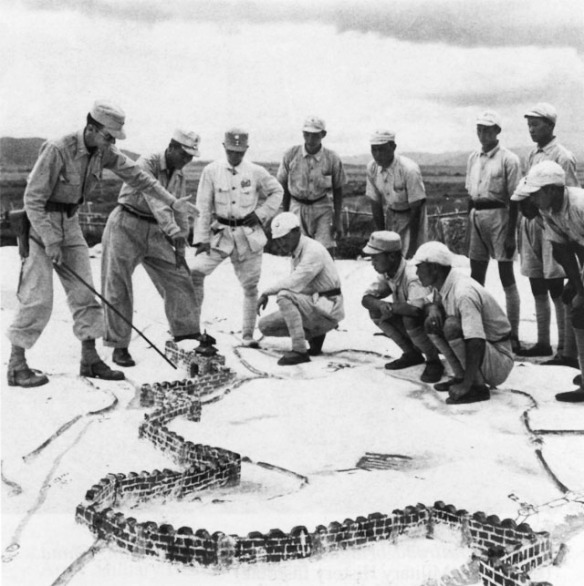
It is ironic that the Japanese army, which had tended to worry about the Soviets and to ignore the Americans, played a vital role in bringing about the war against the United States. The single most important reason can be found in the China theater. Ever since the unplanned Marco Polo Bridge affair at Peking in July 1937, the army had found itself sinking into a quagmire that prescient staff officers likened to Napoleon’s campaigns in Spain. When the first serious clashes erupted in north China, the entire Japanese garrison force amounted only to five thousand or six thousand men, built around one infantry brigade. At Shanghai, the navy had no more than four thousand bluejackets ashore. This modest scale of deployment reflected the fact that military plans did not envisage China as a principal national enemy. In 1936 the army general staff even ordered the China Garrison Army to train for operations against the Soviet army. The Japanese unit involved in the fateful fire fight at the Marco Polo Bridge in July 1937 was engaged in anti- Soviet, not anti-Chinese exercises. As fighting expanded between China and Japan in 1937, the original Japanese intention was to strike rapidly and capture a few key points. On the basis of fairly recent experience in Manchuria in 1931 and at Shanghai in 1932, it was widely thought that full-scale hostilities would be unnecessary, that local combat and threats of force could overwhelm the Chinese and cause the Nationalist government to sue for the cessation of hostilities on terms favorable to the Japanese.
The Chinese fought desperately, but they could not check the invaders, who soon overran Shantung, north China, and Shanghai. But contrary to Japanese expectations, the Chinese would not yield. Chiang Kai-shek ordered national mobilization. In response, Japanese troops, artillery, tanks, and aircraft were rushed to China from the homeland, Korea, and Manchuria, where the Kwantung Army was anxious to finish off the Nationalists and the Communists. Chinese resistance, it was hoped, would collapse if the capital at Nanking were seized. In December 1937 the city fell, Chiang Kai-shek fled, and the inflamed Japanese soldiery went on a rampage of killing, looting, and raping. The scale of the Shanghai-Nanking campaign is suggested by the casualties incurred in six weeks: There were over 70,000 Japanese killed and wounded and more than 367,000 Chinese casualties.
At the outset, the Japanese army general staff had not contemplated committing more than eleven to fifteen divisions to China or even drawing on reserves. Yet by the end of 1937, the Japanese already had had to dispatch sixteen divisions and 700,000 men, approximately the strength of the entire standing army. Although Tsingtao, Amoy, and Hsuchou fell by May 1938, victory was no nearer for the Japanese. A new offensive was launched to capture Hankow, Chiang’s new capital. But neither the seizure of Hankow, nor that of Canton in October 1938, brought the desired end of hostilities. The Chinese established still another provisional capital westward through the gorges of the Yangtze at Chungking. It took the Japanese two more years to push even halfway closer. In June 1940 they reached Ichang, still about three hundred miles from Chungking. Japanese forces in China now numbered twenty-three divisions, twenty-eight brigades (the equivalent of another fourteen divisions), and an air division. The total of Japanese troops in China had risen to 850,000, a level maintained until 19435 when transfers to other theaters began.
Japanese forces in China suffered from or created a vicious circle of their own. The greater the area they managed to carve out, the more troop strength they needed. It was not unknown for local commanders to undertake new and expensive operations whenever the authorities in the homeland spoke of de-escalating the hostilities and limiting the forces in the field. Area commands called for a linkup of enclaves. By and large, the handling of the campaigns in China was of an ad hoc and piecemeal nature, although cumulatively the commitment came to represent a major proportion of total national strength.
Whereas the Japanese army was thinking in terms of Cannae, the Chinese were resorting to the less spectacular but calculated strategy of attrition to dissipate, overextend, and wear down the enemy. In Japan there were widening cleavages between the government and the high command, between the War Ministry and the General Staff, between the authorities in Tokyo and those in the field, and between the army and the navy. Staff meetings in Tokyo often were emotional. Officers were at loggerheads while civilian officials looked on impotently.
On the battlefront, the Japanese forces suffered from shortfalls in ammunition, tanks and equipment, shipping, and landing craft. Casualty tolls from disease and accidents exacerbated combat losses, and there was a shortage of officers as well as a lack of trained reinforcements.
Chinese counterattacks hurt the Japanese locally. From March to May 1938, the Japanese high command could no longer avoid diverting a portion of the troop strength previously reserved for hostilities against the Soviet Union. From this time, therefore, can be dated the Japanese army’s abandonment of hope of localizing the conflict in China, and its loss of flexibility in dealing with the “northern problem.” With the bulk of the Japanese army committed in China, the Kwantung Army in Manchuria had only six regular divisions to confront an estimated twenty Soviet rifle divisions, four or five cavalry divisions, fifteen hundred tanks, fifteen hundred planes, and 370,000 men deployed along the three thousand miles of Siberian and Outer Mongolian frontier. The Soviet air force included three hundred heavy bombers with a range of three thousand kilometers, twice the distance from Vladivostok to Tokyo. Soviet power in the Far East, economic as well as military, had been steadily building up. In a sense, the Kwantung Army was confronting the Soviets with a bluff.